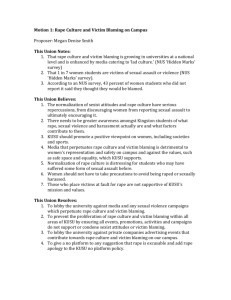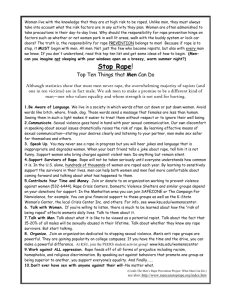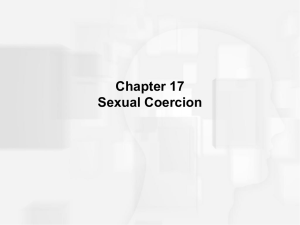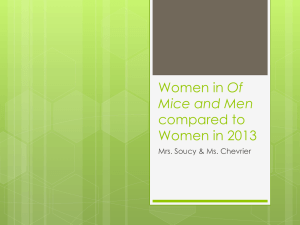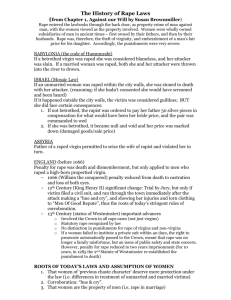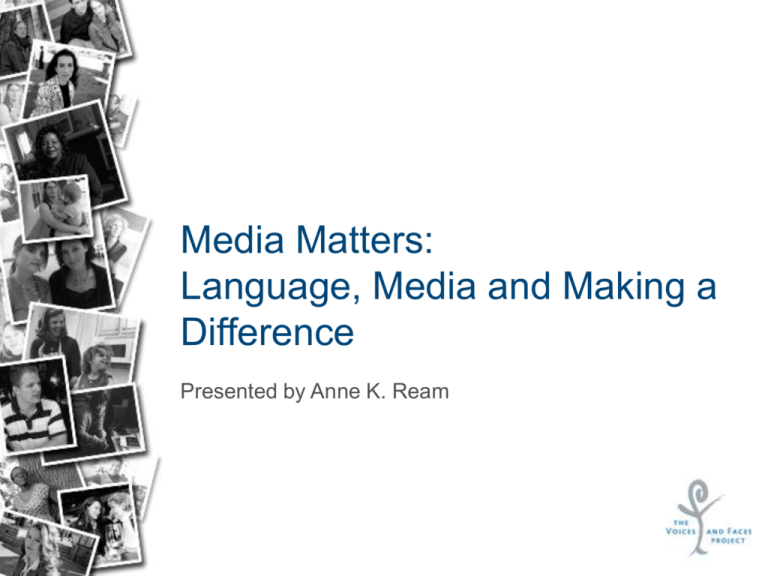
Media Matters:
Language, Media and Making a
Difference
Presented by Anne K. Ream
Despite 30 years of progress by the rape crisis
movement, significant challenges remain
• Incidence of sexual assault remains high
• Reporting by victims still well below average for crimes
overall
• Prosecution and conviction rates are still low
• Victim civil rights not well-supported
• Treatment and support for victims still lacking, especially
among minority and marginalized populations
• Media representations of victims problematic
Rape and sexual violence are discussed more
openly than in the past
• Yet the loudest voices are often the most reactionary
and uninformed
• We exist in an increasingly “uncivil society,” one not
comfortable with victims in general, and rape victims in
particular
• Language is not on our side: how often have you heard
(or said) “Don’t be a victim”
• Media coverage less victim-sensitive than it was 20
years ago
We live in a “rape culture”
• The public fails to understand what constitutes consent
• Many still believe that there are “classes” of rape (“rape”
vs. “rape-rape”)
• How are these attitudes manifested?
Victim blaming: “She asked for it”
Victim disbelieving: “Are you sure it wasn’t just a
misunderstanding?”
Crime minimizing: “Shouldn’t you be over this by now?”
Remember: What gets said outside the courtroom
invariably makes its way inside the courtroom.
Recent high profile
rape cases:
Public Perception
• Kobe Bryant
“A basketball star wouldn’t need to
rape anyone to have sex.”
• Duke lacrosse team
“She’s a stripper, for God’s sake.”
• Ben Roethlisberger
“Most girls would feel lucky to get to
sleep with someone like Ben
Roethlisberger.”
• Catholic priest scandal
“We love our parish priest and he’s
done a lot of good. We need to
forgive him and move on.”
Public increasingly doubts the victim in highprofile rape cases
• The notion that the false reporting of rape is
commonplace has moved from the fringes to the
mainstream
• What are the facts?
Reliable research shows that only 2–8% of rape reports are
false (versus unfounded)
• The incentives to remain silent are much greater than
the incentive to falsely report
• In our “culture of disbelief,” victims are:
Implicitly encouraged not to report
Often not believed when they do report
Re-traumatized by public reactions to
their claims
This “culture of disbelief” strikes a blow to our
public safety
• Unreported rapes = unprosecuted criminals
• The bottom line: we need a communications strategy
that combats the “myth of the false report.” It’s time for
us to:
Seed the real facts/stats through letters to the editor, blog
posts
Speak carefully but candidly about cases that do occur
Arm our staffs with the facts about false reporting
More effectively engage survivor voices to provide a
balanced perspective
Creating a culture in which victims are believed
means using reliable rape stats
• We are not speaking with “one voice” when it comes to
data on rape (1 in 3? 1 in 4? 1 in 6?)
• We do not clearly define the forms of sexual violence to
which we refer (sexual assault versus rape)
• We too often cite unsound or outdated data
The result: increased public skepticism about the scope and
scale of sexual violence
The solution: use only reliable and current data
on rape
• Cite the source of the data, and make sure our allies do,
too
• Make clear that rape is an underreported crime – even
reliable statistics will not tell the full story
• Use survivor testimony with data when possible: the
“human factor” is key
A great resource: The CounterQuo Stats Project includes
vetted and reliable data on rape and sexual violence:
counterquo.org
Rethinking our use of language
(inside and outside the court of law)
• “Movement-speak” works when preaching to the
converted, but does it work with the public
• Leading with ideology can lead people who haven't
"bought in" to shut down.
• Beware words that are linked to partisan policy – or at
least be aware when you are using them
(Gentzkow/Shapiro)
Rethinking our use of language
(inside and outside the court of law)
• Survivor stories, well-told, can break through barriers of
race, class, ideology.
• Meaning matters: it’s time to reclaim words that were
once loaded (victim/survivor debate)
• Imprecise use of language can make or break a case in
court. Understanding the challenges faced by
prosecutors is key.
Leading, not following:
Making new media work for us
Our “rape culture” is fueled by the media—
and impacts legal outcomes
• In traditional or “mainstream” media (msm), content is
controlled by a few:
Directors and producers
Editors and publishers
Noted columnists/journalists
• For this reason, influencing msm content has historically
been difficult
• The rise of “new media” allows us to have a stronger
voice
So, what does that mean for the movement to end
sexual violence?
We live in the age of “everybody’s an expert”
• User generated content (UGC) gives us the power to
drive the public discussion about rape:
Sites, ’zines and blogs
Social Networks: Twitter, Facebook, MySpace, Digg
YouTube, Vimeo
The comment sections in online news sources
• Fewer people than ever consume traditional media
Average age of print newspaper reader? Close to 60
Average age of local TV news viewer? 50+
Net: the future is online, so we must be, too!
Our opportunity, our challenge
• We have the chance to shape public opinion – but so do
those who blame and shame victims
• We “vote” with our online voices so if we don’t weigh in,
our issue “loses”
• In the online world, unreasonable perspectives are often
given more weight than reasoned ones
• We can’t afford to “opt out” of a discussion that
“undecideds” are listening to (on or offline)
• It’s time to get comfortable with new technologies in
order to have a more influential voice
What do we need to do right now?
• Get our pro-victim message out often and loudly so that
the sheer weight of opinion shifts
• Be credible spokespeople for our issue, using reliable
stats and presenting our POV in a reasoned, considered
way
• Appear in media that people trust
• Beware of “preaching to the choir” or the “unmovable”
The 20/20/60 rule
• Respond immediately and forcefully to victim blaming or
stereotyping – opting out means
giving up
Want to change the rape culture?
Collaboration is key.
• We can’t respond to every high-profile rape case – but
we can find someone trusted who has.
• Technology allows us to share important perspectives
swiftly.
• Circulate blog posts/letters to the editor/articles through
Digg, Facebook, Tweets, etc.
• Develop and share “reporter’s toolkits”
• http://www.publicintegrity.org/investigations/campus_ass
ault/toolkit/
• Use Google alerts and share what you find.
The power of you
• Some things you can do now:
Cultivate a relationship with local journalists whose work
you like/trust
Seed story ideas: you are an expert, so reach out!
Build an email database and use it when you need to
spread a point of view or encourage a mass response
Comment on blogs, FB pages, Zines: never stay silent in
the face of damaging opinions
Participate in influential online discussion groups
Get comfortable with Facebook, Twitter, Vimeo, YouTube
When in doubt: ask an intern or younger staffer.
Write letters to the editor: the chances of
a good letter being printed are excellent
Lead, don’t follow: Thoughts on talking about
high-profile cases involving charges of rape
• Talk about individual cases, in a way that furthers a
bigger picture agenda.
• Respect the individual who comes forward with rape
charges while seeding the message that rape and
sexual assault are systemic problems.
• Don’t weight in with a verdict without being armed with
the facts.
Our challenge is to:
• Understand that systemic problems will not be solved by
a single guilty verdict, and cannot be deemed illegitimate
by a not-guilty verdict.
• Talk more about what we KNOW to be true, and less
about what we believe to be true.
Remember:
• As advocates, our first job is to believe victims. But when
we talk about cases in the public square we need to talk
less about the specifics of a single case and more about
what we see on a larger scale.
Weighing in without the facts is never wise. Talking about
the bigger picture almost always is.
Directing their attention to the bigger picture:
Real questions, real answers about “Duke”
Q. Do you think the Lacrosse players are guilty?
A. I have not seen all of the evidence, and this case needs
to be tried in the court of law. But the conditions
witnesses have described – the gathering of a large
group of men, where there was drinking, the hiring of
erotic dancers and a racial and class imbalance – are
conditions where sexual violence often does occur
The public reaction to this case has reinforced what
many survivors most fear: that they will be blamed and
shamed if they come forward with rape charges. This is
a dynamic that makes communities less safe for all of
us.
Directing their attention to the bigger picture:
Real questions, real answers about “Duke”
Q. The accuser’s testimony keeps changing. Doesn’t that
prove that she is a liar?
A. Many victims of violent crime have difficulty recalling the
specifics of the crime. Conflicting testimony is not
unusual. Those schooled in rape trauma syndrome will
tell you that (this) can be the result of many things,
including confusion, fear, and the duress of being
repeatedly questioned. Many survivors have
experienced this, and it does not mean that they are
“liars.”
The common thread: reply to a case-specific
question with a bigger picture answer.
• These answers “transcend” any case outcome.
• They are victim-supportive, but not victim-specific.
• When in doubt, channel Ronald Reagan: Find a way to
make your key points regardless of the questions asked.
What We Believe
• Advocacy and direct services must continue to be
movement priorities. But we MUST also invest in
strategic communications.
• Individual survivor stories help the public better
understand global truths about violence against women.
It’s our job to get them out there.
• Time and investment in communications is not a “nice to
have,” it’s a “must-have” if we seek to change minds,
hearts and public policies.
• We are losing the message wars. We need to change in
order to change that.
What We Believe
• For rape survivors, the enemy of change is silence.
• Our job is to find new ways and places for survivor
voices and perspectives to be heard.
• The good news? It’s never been easier to share our
stories.
What We Believe
• Survivor voices are not enough
• We need your voice, too
• Stand up, speak out, dare to disagree with conventional
wisdom
• Know that media need not be the enemy – it can be a
powerful tool when used and engaged strategically
• Let’s go!




